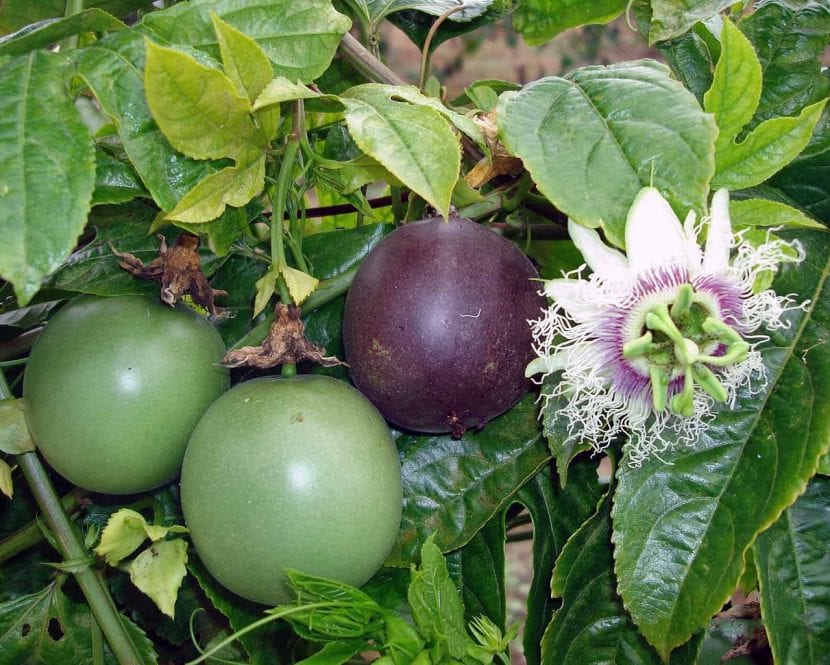
La passion fruit It is a very useful tropical-looking climber: it produces beautiful flowers and its fruits are also edible. The growth rate is fast, so having it covering, for example, a pergola is a very interesting option 😉.
But How to have it well cared for? If you are wondering this, it is because you have probably just purchased a copy or are planning to do so, so below I am going to answer your question.
Origin and characteristics
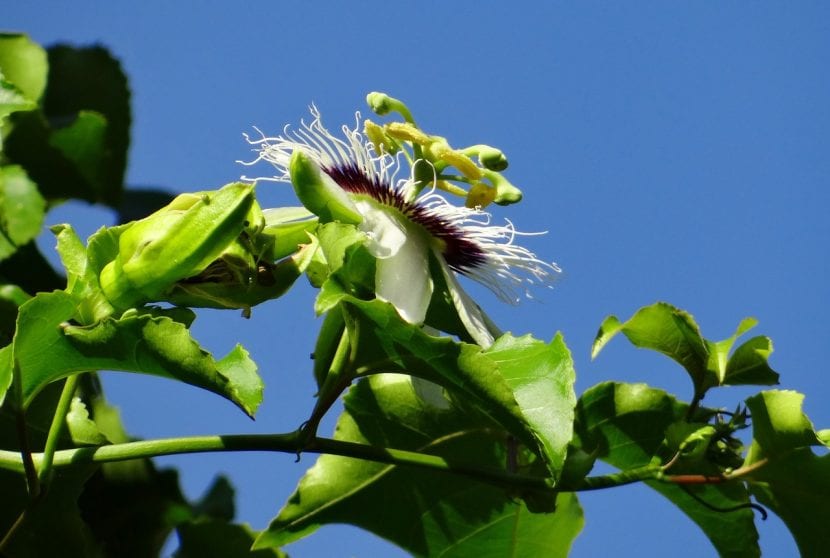
It is an evergreen climbing plant native to South and Central America whose scientific name is Passiflora edulis. It is popularly known as passionflower, fruit of passion or passion fruit, and can reach 20 meters in length as long as it has support to climb on. Its stem is woody and rigid, and alternate, evergreen, dark green leaves sprout from it.
The flowers can measure between 5 and 10cm in diameter, the largest being those produced by cultivars. These are aromatic, white, intense red or pale blue. And the fruit is an oval or round berry with edible pulp, about 4-10cm in diameter, with a thick rind and not suitable for consumption. The seeds are small.
Cultivars
There are many, such as:
- muico: purple fruits
- Little: yellow
- Wow: yellow
- Yee: yellow
- Passion fruit: yellow
What are their cares?
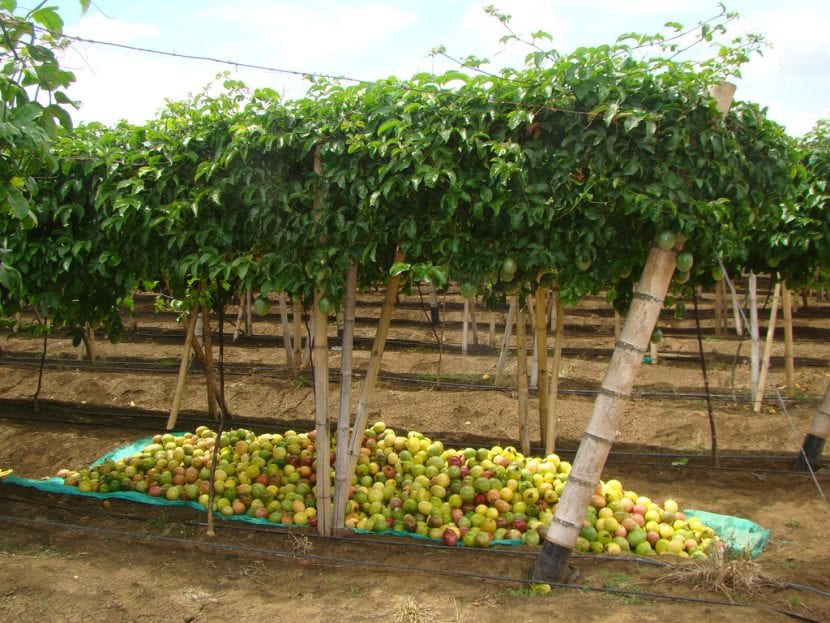
Image - Flickr / John Ocampo
If you want to have a copy, we recommend you take care of it as follows:
Location
It is a plant that must be outside, in a very bright area (it can be direct sun).
Indoors it does not adapt well, although if winter is very cold it can be kept in a room with good light and protected from drafts.
Earth
- Garden: grows in soils rich in organic matter and with very good drainage.
- Flower pot: use universal growing medium (get it here) mixed with 20% perlite, pumice or similar.
Irrigation
The frequency of irrigation will change throughout the year, but it must always be borne in mind that passion fruit is of tropical origin, from a warm and rainy forest. This means that it will only grow during the months that have a mild temperature, between 15 and 30 degrees Celsius; the rest, its rhythm slows down and the land also takes longer to dry out.
Therefore, depending on the climate in our area, we will water more, or less. For example, supposing that we live in a place where in summer it is very hot and rains little, and in winter the temperatures are mild, We will water it an average of 4 times a week in warm season and an average of 2 times a week the rest.
Even so, to avoid problems it is highly recommended to check the humidity of the soil before watering, either with a digital humidity meter or with a thin wooden stick.
Subscriber
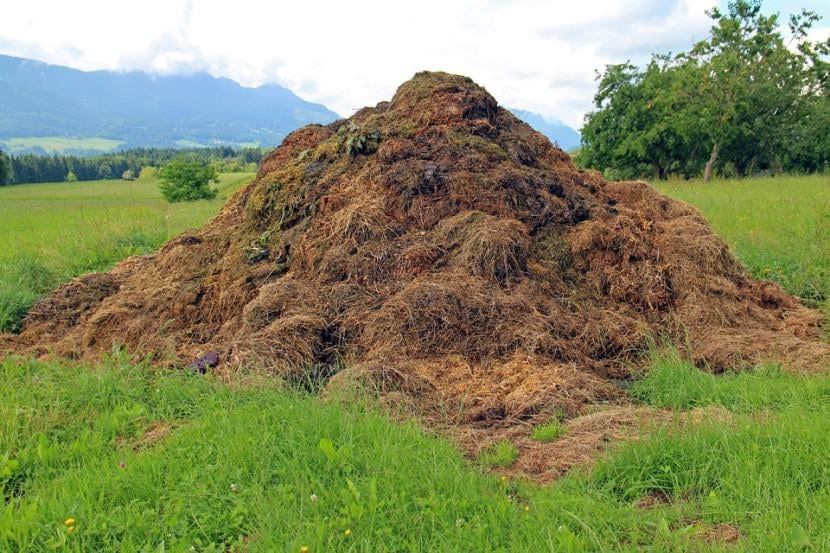
En spring and summer, with Organic fertilizers since its fruits are suitable for consumption. In case of having it in a pot, we will pay using liquid fertilizers, following the instructions specified on the container.
Multiplication
Passion fruit multiplies by seeds and cuttings in spring. Let's know what is the step by step:
Seeds
- First, we will fill a pot with universal growing substrate and water.
- Then, we will throw the seeds on the surface, ensuring that they are separated from each other.
- Later, we will cover them with a thin layer of substrate.
- Then we will water again.
- Finally, we place the pot outside, in semi-shade.
Thus they will germinate in 2-3 weeks at a temperature of 18-22ºC.
Cuttings
To multiply the passion fruit by cuttings you have to cut a stem of about 30cm, impregnate its base with for example cinnamon is a homemade rooting agent, and plant it in a pot with vermiculite (get it here) previously moistened with water. In this way, it will root in 3-4 weeks.
Pests
It is very resistant, but it can be attacked by:
- Mites: like the red spider. They feed on the sap of the leaves, and depending on the species they weave cobwebs between them to be able to move around. See file.
- Mealybugs: mostly cottony, but they can be limpet type. They love to adhere to the leaves and young fruits to feed. See file.
- Aphids: they can be brown, yellow, green or even red, and they measure about 0,5cm. They feed on the sap of leaves and flowers. See file.
These three pests are well controlled with ecological insecticides, such as potassium soap (on sale here), The neem oil (on sale here) nor diatomaceous earth (on sale here).
Pruning
After flowering, 2 or a maximum of 3 buds must be cut from the stems that have already flowered.
Planting or transplanting time
En spring, when the risk of frost has passed. If it is potted, move it to a larger one every two or three years.
Rusticity
It does not resist frost and it does not like cold much either. The minimum temperature that it holds is 0º.
What are its uses?
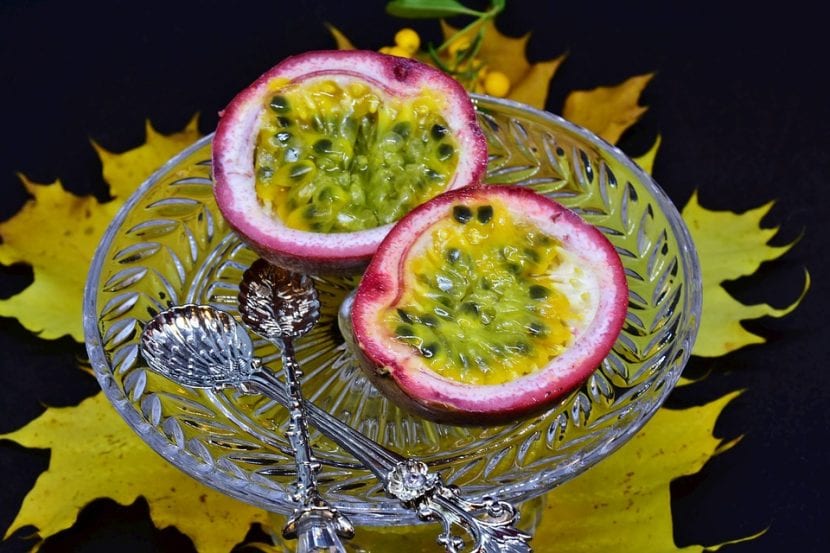
Ornamental
The passion fruit is a very decorative plant, ideal for warm pergolas, lattices or walls of gardens (or terraces 😉).
Edible
The pulp of the fruit is edible; in fact, It is used in confectionery and pastry. Juices, syrups and cocktails are also made. In addition, it can be consumed fresh.
Its nutritional value per 100 grams is as follows:
- Carbohydrates: 23,38g
- Sugars: 11,20g
- Fiber: 10,4g
- Fat: 0,70g
- Proteins: 2,20g
- Water: 72,93g
- Vitamin A: 64 μg
- Vitamin B1: 0mg
- Vitamin B2: 0,130mg
- Vitamin B3: 1,500mg
- Vitamin B6: 0,100mg
- Vitamin C; 30mg
- Vitamin E: 0,02mg
- Vitamin K: 0.7 μg
- Calcium: 12mg
- Iron: 1,60mg
- Magnesium: 29mg
- Phosphorus: 68mg
- Potassium: 348mg
- Sodium: 28mg
- Zinc: 0,10mg
Medicinal. What are the health benefits of passion fruit?
All these:
- Relieves muscle pain and upside down.
- Reduces cough. It also helps with asthma and other respiratory problems.
- Strengthens the immune system, due to its content in vitamins, especially A and C.
- Regulates digestion, so it is interesting to include it in the diet if you have constipation problems.
- Es diuretic, so it serves as a food that helps to lose weight.
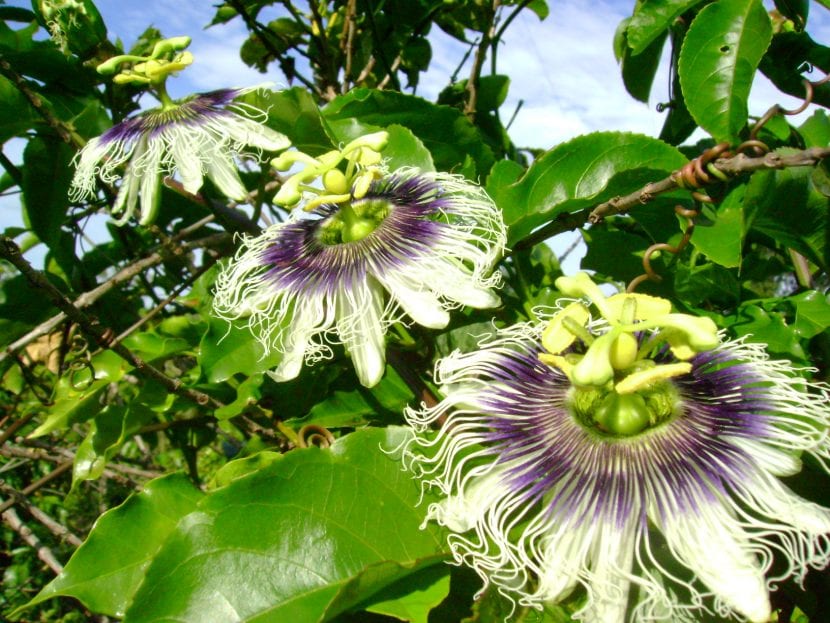
Image - Wikimedia / Claudemir Brundani
What did you think of the passion flower?
I think I have one, but it has never borne fruit so I doubt it is, the flower is the same and they told me it is called passionflower, the tenfo in a pot in the garden, but it does not bear fruit. What I can do.
Thank you
Hi Olivia.
Passion fruit flowers are hermaphroditic. Your plant may be still young, or it may be lacking space or compost. It would be good to fertilize it in spring and summer with an organic fertilizer, such as cow manure or guano, following the manufacturer's instructions.
Greetings.
I liked it. It is simple and easy to understand. Thanks for sharing it with us.
Thank you for sharing your opinion 🙂
Regards!
hello the leaves are consumed?
Hi Fabiana.
I understand that they are used to make infusions, and that they are taken mainly to be able to fall asleep and / or relieve stress. But it is better that you consult a herbalist.
Regards!
I have a beautiful large plant and I didn't know all the properties it had. Thank you very much. Very good information!
Hi Guillermo.
Thank you very much for your words 🙂
A greeting.
How does it withstand the wind?
Hello Fernando.
Well, it depends on whether the area is very or slightly windy. For example, if it blows hard only on specific days, it will not harm it; but if, on the other hand, he does it frequently, then it could greatly delay his growth.
A greeting.
I have one, it's very big, but it never gave me strawberries, although it grows many flowers. What can be? why doesn't it work for me?
Hi carmen.
From what I understand it is difficult for them to bear fruit. That is why pollination is cross-pollination, carried out by insects (bumblebees, specifically).
What can also be done is take a small brush, and pass it through the flowers during all the days that they remain open. But yes, you have to go through one first, then another, and then return to the previous one.
A greeting.